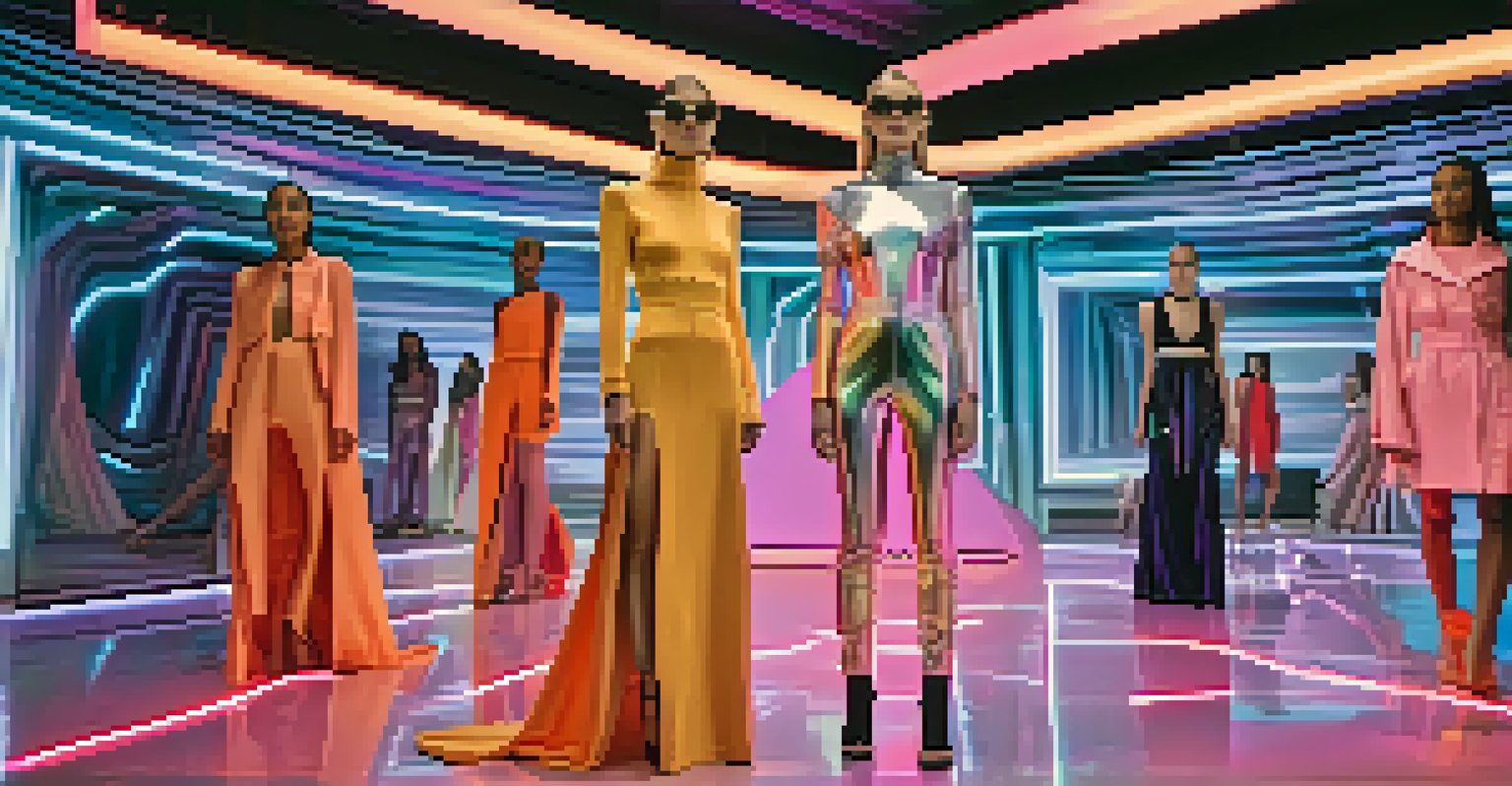Sustainable Fashion: Identity and Social Responsibility

Understanding Sustainable Fashion and Its Importance
Sustainable fashion refers to clothing that is designed, manufactured, and sold in ways that are environmentally friendly and socially responsible. This means considering the lifecycle of garments, from the materials used to the ethical treatment of workers in the production process. As consumers become more aware of the environmental impact of fast fashion, the demand for sustainable options has surged.
Fashion is the armor to survive the reality of everyday life.
The importance of sustainable fashion lies not only in reducing waste but also in promoting a more ethical approach to clothing. For instance, brands that prioritize sustainability often use organic materials or recycled fabrics, which significantly cut down on pollution and resource depletion. By choosing sustainable fashion, consumers can express their identity while supporting practices that align with their values.
Related Resource
Moreover, sustainable fashion encourages a shift in mindset. Instead of viewing clothing as disposable, it invites consumers to appreciate quality and longevity. This not only helps reduce the environmental footprint but also fosters a deeper connection to what we wear, allowing our clothing choices to reflect our personal stories and commitment to sustainability.
The Role of Identity in Fashion Choices
Fashion is a powerful means of self-expression and identity formation. The clothes we wear often communicate our values, beliefs, and social status to the world. In the context of sustainable fashion, this means that individuals can use their wardrobe choices to advocate for environmental and social issues, making their fashion statements resonate beyond just aesthetics.

For example, consider a person who chooses to wear clothing made from recycled materials. This choice not only showcases their unique style but also signals their commitment to sustainability. In essence, sustainable fashion allows individuals to craft a personal narrative that aligns with their values, contributing to a collective movement toward social responsibility.
Sustainable Fashion Redefines Values
This approach allows consumers to express their identity while supporting environmentally friendly and socially responsible practices.
Additionally, as the landscape of fashion evolves, the concept of identity in clothing is becoming more inclusive. Brands are increasingly recognizing diverse identities and catering to various body types, cultural backgrounds, and gender expressions. This shift not only broadens the definition of beauty but also reinforces the idea that sustainable fashion is about more than just the product; it's about the people behind it.
Social Responsibility: A Core Principle of Sustainable Fashion
Social responsibility in fashion encompasses the ethical treatment of workers and the communities affected by the industry. Brands that embrace sustainable practices are often committed to fair labor conditions and transparency in their supply chains. This approach not only ensures that workers are treated fairly but also fosters a sense of community and trust between consumers and brands.
The greatest threat to our planet is the belief that someone else will save it.
For instance, companies that engage in fair trade practices often pay their workers a living wage and provide safe working conditions. This not only empowers individuals but also uplifts entire communities, creating a ripple effect of positive change. By supporting brands that prioritize social responsibility, consumers can contribute to a more equitable fashion industry.
Related Resource
Moreover, social responsibility extends to environmental stewardship. Brands that are committed to sustainability often invest in eco-friendly practices, such as reducing waste and conserving resources. This dual commitment to people and the planet reflects a broader understanding of what it means to be responsible in the fashion industry, encouraging consumers to be mindful of their purchasing decisions.
The Impact of Consumer Choices on Sustainable Fashion
Consumer choices play a pivotal role in shaping the future of sustainable fashion. When individuals opt for brands that prioritize ethical and eco-friendly practices, they send a strong message to the industry about the demand for sustainability. This, in turn, encourages more brands to adopt responsible practices, creating a positive feedback loop.
For example, by choosing to buy second-hand clothing or supporting local artisans, consumers can contribute to a more sustainable fashion economy. Thrift shopping not only reduces waste but also promotes a unique style that celebrates individuality. Each purchase becomes a statement that reflects personal values and a commitment to sustainability.
Consumer Choices Drive Change
When individuals support ethical brands, they create a demand for sustainability that encourages the entire industry to adopt responsible practices.
Additionally, engaging in mindful consumption—where consumers assess their needs rather than succumbing to trends—can significantly reduce the environmental impact of fashion. By making informed choices, individuals can transform their wardrobes into a reflection of their values, proving that fashion can be both stylish and responsible.
The Importance of Transparency in the Fashion Industry
Transparency is a critical aspect of sustainable fashion, as it allows consumers to make informed choices about the brands they support. When companies openly share information about their production processes, material sourcing, and labor practices, it builds trust and accountability. This transparency empowers consumers to hold brands accountable for their practices.
For instance, brands that provide detailed information about their supply chain can demonstrate their commitment to ethical practices. This not only attracts conscious consumers but also sets a benchmark for other companies to follow. In an era where information is readily available, consumers are increasingly seeking brands that are honest about their impact on the environment and society.
Related Resource
Furthermore, transparency fosters a culture of collaboration within the industry. When brands share best practices and learnings, it encourages innovation and collective progress toward sustainability. By working together and prioritizing transparency, the fashion industry can move toward a more responsible future, aligning with the values of today's consumers.
Innovative Approaches to Sustainable Fashion
Innovation plays a crucial role in the evolution of sustainable fashion, as brands explore new materials and production methods that minimize environmental impact. For instance, some companies are experimenting with plant-based fabrics, which are biodegradable and require fewer resources to produce. This not only reduces waste but also presents exciting new options for consumers seeking sustainable choices.
Additionally, technology is transforming the fashion industry, with advancements like 3D printing and digital fashion design reducing the need for physical samples and minimizing waste. These innovative approaches allow for more efficient production processes, aligning with the principles of sustainability while meeting consumer demand for unique and customizable products.
Transparency Builds Trust in Fashion
Open sharing of production processes and labor practices empowers consumers to make informed choices and hold brands accountable.
Moreover, collaborations between fashion brands and environmental organizations are becoming more common. By working together, they can create campaigns that raise awareness about sustainability and promote responsible practices. These partnerships highlight the potential for innovation to drive positive change, making sustainable fashion not just a trend but a movement.
The Future of Sustainable Fashion: Trends and Predictions
As awareness about environmental issues continues to grow, the future of sustainable fashion looks promising. Trends indicate a shift toward circular fashion, where products are designed for longevity and recyclability. This approach not only minimizes waste but also encourages consumers to invest in quality pieces that stand the test of time.
Additionally, the rise of digital fashion suggests a transformative shift in how consumers engage with clothing. Virtual fashion shows and digital wardrobes are gaining popularity, allowing consumers to explore style without the environmental impact of traditional fashion. This trend could pave the way for a more sustainable future, where clothing is experienced rather than consumed.

Ultimately, the evolution of sustainable fashion will depend on the collective efforts of consumers, brands, and industry stakeholders. By prioritizing sustainability and social responsibility, the fashion industry can create a future that not only celebrates individuality and identity but also respects the planet and its people.